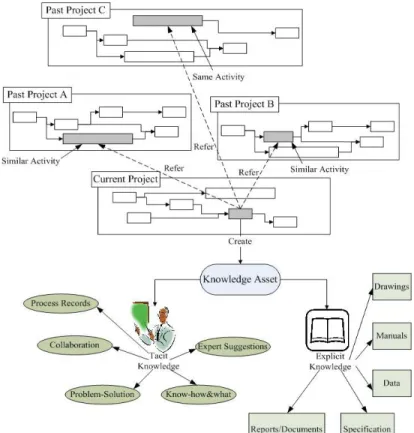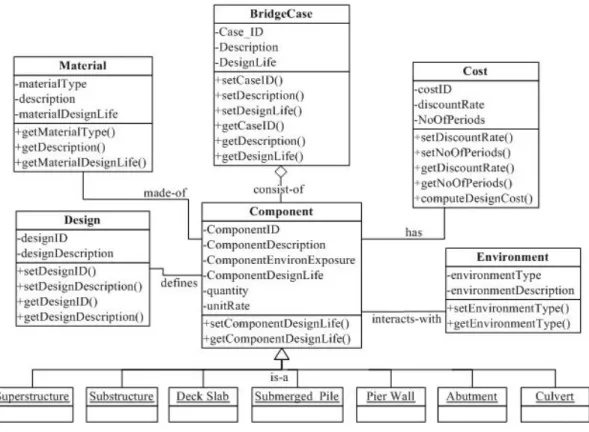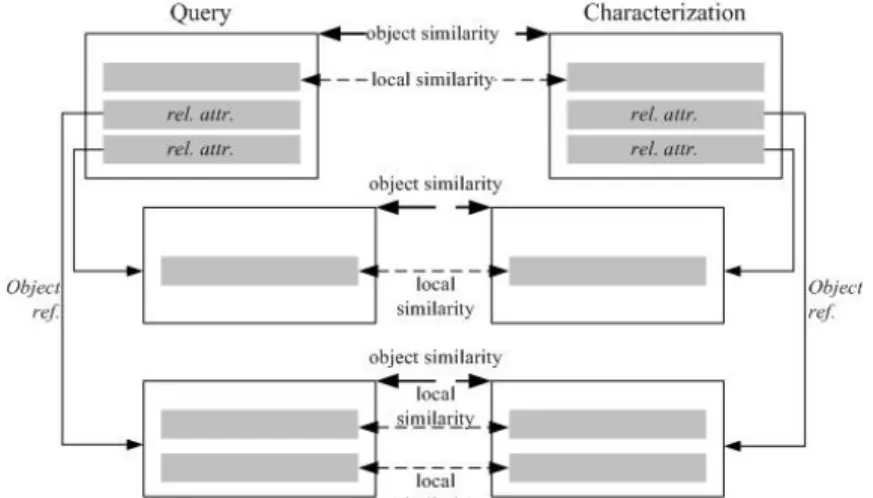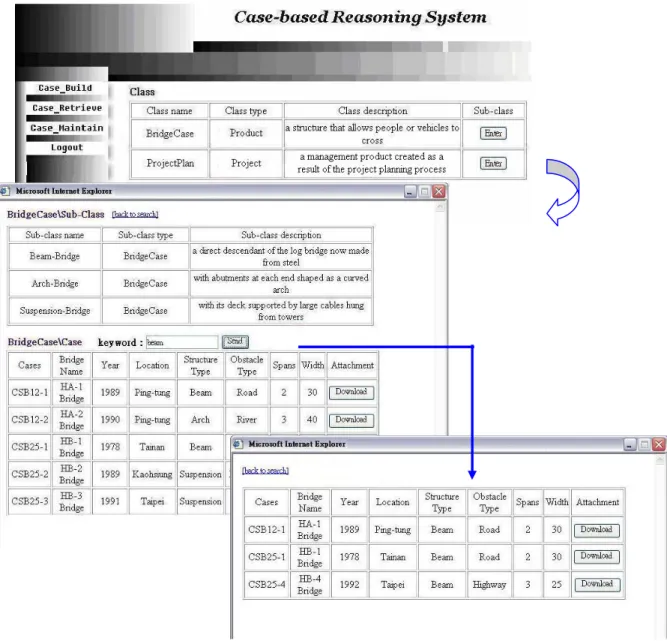行政院國家科學委員會專題研究計畫 成果報告
協同式新產品開發環境的智慧型工程知識管理技術開發
研究成果報告(精簡版)
計 畫 類 別 : 個別型 計 畫 編 號 : NSC 95-2221-E-151-003- 執 行 期 間 : 95 年 08 月 01 日至 96 年 07 月 31 日 執 行 單 位 : 國立高雄應用科技大學工業工程管理系 計 畫 主 持 人 : 何正得 共 同 主 持 人 : 陳裕民 計畫參與人員: 碩士班研究生-兼任助理:張豪 報 告 附 件 : 出席國際會議研究心得報告及發表論文 處 理 方 式 : 本計畫涉及專利或其他智慧財產權,1 年後可公開查詢中 華 民 國 96 年 10 月 01 日
行政院國家科學委員會補助專題研究計畫
■ 成 果 報 告
□期中進度報告
協同式新產品開發環境的智慧型工程知識管理技術開發
計畫類別:■ 個別型計畫 □ 整合型計畫
計畫編號:NSC 95-2221-E-151-003
執行期間: 95 年 8 月 1 日至 96 年 7 月 31 日
計畫主持人:何正得
共同主持人:陳裕民
計畫參與人員: 張豪
成果報告類型(依經費核定清單規定繳交):■精簡報告 □完整報告
本成果報告包括以下應繳交之附件:
□赴國外出差或研習心得報告一份
□赴大陸地區出差或研習心得報告一份
■出席國際學術會議心得報告及發表之論文各一份
□國際合作研究計畫國外研究報告書一份
處理方式:除產學合作研究計畫、提升產業技術及人才培育研究計畫、
列管計畫及下列情形者外,得立即公開查詢
□涉及專利或其他智慧財產權,■一年□二年後可公開查詢
執行單位:國立高雄應用科技大學
中 華 民 國 96 年 09 月 10 日
中文摘要:
本計畫主要目的是開發一協助協同式新產品開發的案例式推理系統。本研究將案例式 推理系統(Case-Based Reasoning System, CBRS)結合協同設計(Collaborative Design)的理 念,開發出可以運用於新產品協同開發之案例式推理系統。此一系統架構是以產品資料管 理系統(Product Data Management System, PDMS)為基礎,於案例式推理系統中篩選出的案 例可以由 PDMS 下載相關設計資料。藉由選擇本公司或協同公司中的新產品開發之專案資 料庫的歷史專案,可以縮短並且改善新產品開發之流程與品質。本研究之主要研究議題為 CBR 協同作業機制與安全控管機制的建立,以增進協同公司間產品開發的效率並且能保持 公司的智慧財產。本研究之雛形系統是以 java, JSP 撰寫程式並使用 Apache 軟體基金會的 Tomcat 運用程式伺服器,併使用 MySQL 為後端資料庫。此一系統可以實作於微軟的 Windows 作業系統或是其他 Linux 或 UNIX 作業系統。因此對於協同公司間的軟硬體並無 特殊限制,可以充分發揮 java 跨平台的特性。
關鍵詞:案例式推理、新產品開發、協同開發
Abstract (英文摘要)
The objective of this research project is to develop a case-based reasoning system (CBRS) to assist engineers develop new products in collaborative environment. This project combined the collaborative design concept with Case-Based Reasoning System (CBRS). The framework of the system is built upon the product data management system (PDMS).Therefore, the relevant files associated with the selected design cases from CBRS can be downloaded from PDMS. The workflow and quality of new product development can be improved through this sharing mechanism of historical design cases within the collaborative partners. The major issues in the research are access control mechanism and sensitive content control between collaborating partners. These mechanisms will improve the design information sharing efficiency without compromising the intellectual properties of the collaborative partners. The pilot system is built upon Tomcat of Apache Software Foundation with MySQL as backend database. The system can be implemented in Microsoft Windows or Linux operating systems. Therefore, there are no restrictions on the hardware or software platform restrictions for the collaborative partners.
一、
前言:
由於臺灣製造業最大的競爭力在於產業垂直分工,使各環節都以最有效率的方式運 作。為增加產業競爭與獲利能力,台灣產業已逐漸由 OEM 轉成 ODM。在 ODM 運作下最 重要的是產品研發能力。今日多數產業開發新產品時均採用上、下游廠商協同式作業方式, 雖然有協同式產品資料管理系統(NSC92-2212-E-151-003)的協助可以讓開發流程順暢,可是 智慧型工程知識管理系統如何能在協同式作業環境下,取得協力廠商的知識卻是一大挑戰。
二、
研究目的:
本計畫目的為開發協同式新產品開發環境的智慧型工程知識管理技術,使製造業在開 發新產品的流程可以因為前人知識的協助而加快,也使我國的製造業更有競爭力。三、
文獻探討:
Rodgers 等人[2]開發 WebCADET 系統,可以讓設計團隊在產品開發初期的概念設計階 段透過網頁介面的協助進行溝通及決策,同時可以儲存此一時期的知識。此一架構儲存所 有參與溝通討論者的知識,參與者的自主選擇的權利,而且只支援產品開發初期的概念設 計。以台灣目前協同作業的現況而言,一家公司可能與同為競爭對手的數家公司合作,如 何保有自己的核心知識,又能對產品協同開發有貢獻是此一機制能否成功的主要關鍵,因 此本計劃將針對跨組織的知識分享及控管機制進行研究,使協同作業的夥伴公司都能放 心的與其它協同作業夥伴公司分享其知識。 智慧型系統主要以兩種形式為主要代表:1. 規則推理型(rule-based reasoning),2. 案 例推理型(case-based reasoning)[3]。其中規則推理型主要應用於某一單一問題,例如工作排 程系統[4],這些問題的特點是有大量已經驗證的邏輯關係,此類系統屬於較靜態,將系統 建立後鮮少更動。而案例推理型主要應用於尚無完整已經驗證的邏輯關係而且有較廣泛的 應用範圍的系統[5],此類系統屬於動態型,最近似的案例被取出後如果沒有完全與問題所 需一致,則使用者或系統需要修改解決方案(adaptation)後將新案例存入系統中。案例推理 型系統主要的優點有[6, 7, 8]: z 先前留存的解決方案可以縮短尋求各項限制條件下的所花費的時間, z 如果能夠從案例中推演出絕對輪廓(abstract schemata)則可以歸納出通用的 知識 (generalized knowledge), z 規則推理型主要的工作是知識的萃取,而案例推理型可以僅是案例的蒐集。 案例推理型系統會隨著時間增加知識,而系統的成功關鍵就在案例系統儲存與擷取方 法的設計與開發[3]。案例推理型的存取方法可以分為三大類[9]:文字型(textual CBR)、對 話型(conversational CBR)與結構型(structured CBR)。文字型案例推理型系統主要適用於文字 為主的知識領域,如型錄、手冊、報告、產品描述等。對話型案例推理型系統是文字型延 伸,強化了與使用者的對話介面,由系統發出一系列的問題來協助使用者擷取所需案例。 此種方法可以讓使用者更易於使用,可是因為各種不同應用時的介面差異會相當大,因此 需要針對個別系統設計不同的對話介面。 結構型案例推理型系統適用於中大型案例推理型系統,每一案例有一附加的框架 (frame),用以儲存案例的各項屬性。這些屬性可以是一般的參數,或是結構型的物件導向 式(object-oriented)[10]。此型可以將多類型的案例整合在一起,不必為某單一問題建立一套 系統,因此本計畫將採用此一方式。Counsel 等人 [11]開發出儲存及管理自動化精密機械的 設計知識。其主要目標即是將過去的設計資料經過分類,可以使新設計專案開始時可以搜 尋到近似的設計以加速專案的進行,本研究參考利用此一方法設計搜尋方案,但是需要人 工將過去資料分類,新案例也需要人工加入尚未達到本計畫目標。Perera 與 Watson [10]開 發一協同式建築估價與設計案例系統(NIRMANI),將日常檔案資料管理系統與案例系統結 合 , 協 助 工 作 人 員 對 專 案 進 行 估 價 與 設 計 。 NIRMANI 應 用 物 件 導 向 特 徵 為 基 (OO feature-based)的技術儲存與擷取案例,與本研究團隊已經開發的系統[12]十分相近。 本計畫認為物件導向式結構型案例推理型系統較適用於有多種產品,而且產品有多家 公司協同設計的環境。參與協同設計公司間案例資料的流通將會是本計畫的研究重心。Shiu 等人 [13]以代理人(agent)技術建立協同式案例推理系統(collaborative case-based reasoningsystem),主要是以 Fuzzy Integral 來決定各代理人之間較佳的案例。此法主要針對協同式案 例系統,各系統間並無一定關係,因此此一技術雖然有效但是較為複雜。本計畫中的系統 有產品結構資料可以應用,因此可以更快速有效的蒐集各協同公司的案例來決定較佳的案 例。
四、
研究方法:
本計畫首先構建一植基於產品資料管理系統的案例式推理系統,如圖一所示 [14]。此 一系統可以解決公司內新產品設計資料管理與分享的問題。對於多樣產品的公司,本系統 應用物件導向觀念設計案例式推理系統,產品及其組成部品的資料可以抽象化的以類別表 示,如圖二所示。,與產品資料管理系統中的物料清單(BOM)可以相會對應,其對應關係 如圖三所示。在每一類別中均有其特有的特性(attribute),子類別可以繼承父類別的特性。 因此雖然在背光模組中沒有尺寸的特性,可是當搜尋背光模組設計案例時,尺寸仍會是需 要輸入的特性值。在搜尋時,系統會根據使用者輸入的特性值及其權重值(weight)計算出案 例庫內的案例與目標值得接近程度。計算的公式為 ⎟ ⎟ ⎠ ⎞ ⎜ ⎜ ⎝ ⎛ − − − =∑
= − − i m i i i i i w v v T v v C T Simility 1 max min ) ( 1 ) , ( (1) 其中 T 代表目標,C 代表現存於案例庫的案例。 是第 i 個特性值, 則是相對於此 特性值的權重值。 權重值可以用來調整每一特性值的重要性,但是所有權重值須滿足下列 要求: i v wi 1 1 =∑
= m i i w (2) 當案例式推理系統需要在協同的環境下運作時,首先要解決的是協同夥伴公司間的網 路安全問題。第一步需要檢驗的是存取的是否為協同開發產品的夥伴公司,詳細運作如圖 四所示。當筆記型電腦顯示模組廠商要求背光模組廠商的案例時,背光模組廠商需要先確 認對方是協同合作的夥伴。通過驗證後,背光模組廠商將會提供 buyer 版的資料給顯示模 組廠商,示範畫面如圖五所示。Case-based reasoning system
Case library Case feature Similarity Adapted new
Product case 圖一、 整合 PDMS 與 CBRS [14] Produc t structu Produc t item manag Docume nt manager Project manag er Messa ge manag Access manag er Basic data manag Product t t Product it Product it 1 Document Document Product feature Produc t Feature 2 Feature 1 Item 2 Feature 2 Item 1 Feature 1
Notebook Computer -Size -... Display Module -CPU type -...
Main Board Keyboard ...
-Type -... Panel -Brightness -Homogeneity -... Backlight Module ... -attribute class name 圖二、筆記型電腦的類別圖[14] Notebook Computer -Size -... Display Module -CPU type -...
Main Board Keyboard ...
-Type -... Panel -Brightness -Homogeneity -... Backlight Module ... -attribute class name Notebook Computer Display
Module Main Board Keyboard …
Panel Backlight
Module ...
x1 x1 x1
x1 x1
Structure
BOM DiagramClass
Mapping Relationship
Mapping Relationship
圖三、筆記型電腦的料表(BOM)與類別圖的對映圖[14]
Rejected for Display case-231 Request proper version
Security checked
Collaborative Case-Based Reasoning System (CCBRS) Collaboration Service CBR Core Security Service Reduced version of Display case-231 CCBRS Supplier A CCBRS Supplier B
Request for Display case-231 Request for Display case-231
圖五、協同案例式推理系統中協同公司檔案要求運作畫面 [15]
五、
結果與討論:
本計畫首先以物件導向技術,規劃一個以產品資料管理系統為基礎的案例式推理系 統,並發表於國際性研討會[14]。協同運作的安全控管機制是本計畫的重點,參予研究的碩 士生不僅獲得碩士學位[15]而且得到產品設計管理及系統整合的理念。六、
參考文獻
1. Rodriguez, K. and A. Al-Ashaab, 2005, “Knowledge we-based architecture for collaborative product development,” Computer in Industry, Vol. 56, pp. 125-140.
2. Rodgers, P.A., N. H. M. Caldwell, P. J. Clarkson, A. P. Huxor, 2001, “The management of concept design knowledge in modern product development organizations,” International
Journal of Computer Integrated Manufacturing, Vol. 14, pp. 108-115.
3. Cunningham, P. and A. Bonzano, 1999, “Knowledge engineering issues in developing a case-based reasoning applications,” Knowledge-Based Systems, Vol. 12, pp. 371-379.
4. Goldstein, I. P. and R. B. Roberts, 1977, “NUDGE: A Knowledge-based scheduling Program,” Proceedings of 5th International Joint Conference on Artificial Intelligence, pp. 257-263.
5. Alani, H., S. Kim, D. E.Millard, M. J. Weal, W. Hall, P. H. Lewis, and N. R. Shadbolt, 2003, “Automatic ontology-based knowledge extraction from web documents,” IEEE Intelligent
Systems, January/February, pp.14-21.
6. Kolodoner, J. L., 1988, “Extending problem solving capabilities through case-based inference,” in J. L. Kolodoner (ed.), Proceedings of the Case-Based Reasoning Workshop, Clear Beach, Florida, May 10-13, pp. 21-30.
7. Kolodoner, J. L., 1993, Case-Based Reasoning, Mogan Kauffman, San Mateo, CA, USA. 8. Leake, D. B. (Eds.), 1996, Case-Based Reasoning, Experiences, Lessons and Future
Directions, AIAA Press/The MIT Press, Menlo Park, CA, USA.
9. Waheed, A. and Adeli H., 2005, “Case-based reasoning in steel bridge engineering,”
Knowledge-Based System, Vol. 18, pp. 37-46.
10. Perera, S. and I. Watson, 1998, “Collaborative case-based estimating and design,” Advances
in Engineering Software, Vol. 29, No. 10, pp. 801-808.
11. Counsell, J., I. Poter, M. Duffy, 1999, “Schemebuilder: computer aided knowledge based design of mechatronic systems,” Assembly Automation, Vol. 19, No. 2, pp. 129-138.
distributed knowledge model for knowledge management in collaborative development and implementation of an enterprise system,” Robotics and Computer-Integrated Manufacturing, Vol. 20, No. 5, pp. 439-456.
13. Hsiu, S. C. K., Y. Li, and F. Zhang, 2004, “A fuzzy integral based query dispatching model in collaborative case-based reasoning,” Applied Intelligence, Vol. 21, pp. 301-310.
14. Ho, Chengter, 2007, “Object-Oriented Case-Based Reasoning System For New Product Development,” Proceedings of the 11th IASTED International Conference on Internet and
Multimedia Systems and Applications, Honolulu, U.S.A., August 20-22, pp. 30-35.
15. 張豪,2007,新產品開發之協同案例式推理,國立高雄應用科技大學工業工程與管理系, 碩士論文。
七、
計畫成果自評:
本計畫研究成果與閻計畫內容符合,並達成預期目標。除參予研究的碩士生獲得碩士 學位,並於國際性研討會發表成果。於 2007 年 8 月 IMSA2007 發表一篇以物件導向案例式 推理系統為主的論文,並將於 12 月的 APIEMS 發表一篇以協同式新產品開發的案例式推理 系統為主的論文。綜合以上成果將會成為一篇長篇的國際期刊論文八、
附錄:
出國報告國科會專題研究計畫補助專家學者出席國際會議報告
(計畫編號:NSC95-2221-E-151-003)
何 正 得
國立高雄應用科技大學
工業工程與管理系副教授
一、參加會議經過2006 年 International Conference on Intelligent Agents, Web Technologies
and Internet Commerce (IAWTIC,國際智慧型代理人網頁技術與網際網路商務會議) 於 2006 年 11 月 29 日至 12 月 1 日在澳洲的雪梨舉行,會議主題為全球未來的科技管理 (Technology Management for the Global Future)。此次會議共有來自全世界 35 個國家的兩 百多所大學與一百多家公司的二百四十多篇論文發表,在三天的會議期間分別在 48 個 場次發表。會議論文依特性分為 Intelligent Agents, Web Technologies, Internet Commerce 三大範圍,並分為 44 類(track) 分別為:
Intelligent Agents
Knowledge Management Intelligent Business Agents Agent Architectures
Environments and Languages Adaptation and learning for agents Human and agent interaction Interface agents
Mobile agents
Virtual agent-based marketplaces Agents and uncertainty
The privacy issues for agents
Automated shopping and trading agents Agent-oriented services
Social implications for agent
Conceptual modelling and design of Ontologies for agents Agents and e-commerce
Legal aspects of agents in e-commerce
Performance measurement of e-commerce agents Rational information agents and electronic commerce Auction and negotiation for e-commerce agents Knowledge Discovery,
Intelligent Information Systems Knowledge Clustering
Classification Web Technologies
Web data mining and information retrieval Agent-based trade-and mediating services Teaching on Web
Virtual trading institutions Internet Commerce
Reasoning Techniques Electronic Payment Systems Internet Marketing
Intranets and Extranets Electronic Payment Systems Electronic Data Interchange Supply Chain Management Electronic Payment Systems
Internet-based Electronic Commerce
Virtual Communities/Community Networks Logistics Issues for Electronic Commerce
Business Reengineering Issues for Electronic Commerce Government Electronic Procurement and Service Delivery Legal, Auditing or Security Issues for Electronic Commerce Requirements Engineering Approaches for Electronic Commerce
本人之論文 “The Case-Based Reasoning System for Knowledge Management of Engineering Consulting Projects” (工程顧問業知識管理之案例式推理系統 NSC94-2622- E-151-018-CC3) 屬於 Knowledge Management 於十二月一日下午 13:30 - 15:10 發表。會 中對有來自澳洲、美國、台灣、巴基斯坦、荷蘭的學者與業者對知識管理及產業資訊化 的現況與未來發展有相當熱烈的討論。 知識管理是企業電子化後重要的議題,對公司的競爭力有相當大的助益。在目前 的現實面上,即使是已經相當普遍的產業資訊化依舊存在許多的危機。以澳洲墨爾本的 墨爾本理工大學(RMIT)為例,前幾年因為校務系統全面電子化所引取的危機是相當可能 在其他企業發生的。 二、與會心得 此次會議有來自全世界實務經驗豐富的專家與各大學的研究人員,會議中的研討 與會外的討論相當融洽熱烈。資訊系統雖然是相當成熟的產業,可是新技術也不斷的開 發出來,參加此類國際性會議可以藉由交流得到最新的情報,不但可以增進個人專業學 識,更可以知悉各領域的最新發展及將來趨勢。 三、攜回資料名稱及內容
1. Proceedings of IAWTIC ’06 (CD-ROM) 2. Book of Abstracts and Conference Program
The Case-Based Reasoning System for Knowledge Management of
Engineering Consulting Projects
Chengter Ho and Jiang-Jing Chen
Department of Industrial Engineering and Management National Kaohsiung University of Applied Sciences
hoc@cc.kuas.edu.tw
Abstract
Retaining the knowledge acquired from each project is one of the major competitive advantages for engineering consultant industry. The traditional repository of a knowledge management system provides the memory for all the projects done by the company. But, due to the business nature of the industry, the knowledge is dispersed from design and planning for a highway construction project to auditing of sewage constructing project. The retrieval of knowledge becomes a less meaningful search through thousands of documents. The objective of this study is to design a case-based reasoning system with more accurate retrieval technology via object-oriented methodology. The object-oriented frame was designed to organize the knowledge acquired throughout the lifecycle of the engineering projects. The engineering knowledge store in the system can be retrieved in a more precise way through the specification of the object class. The prototype system is constructed by using the java technology. Tomcat server and mySQL are used as the application and database servers. 1. Introduction
Engineering consultant industry provides planning, design, and supervising for engineering projects ranging from manufacturing factory to highway construction. There are no facilities and personnel for manufacturing or constructing in the engineering consultant company. Hence, it is a very knowledge intensive business. The knowledge acquired through all the projects carried out by the company becomes the competitive advantages of the company [2]. In engineering consultant industry, the sharing of experiences and knowledge would greatly reduce the time and cost to solve similar problems recurred over and over again. However, information systems used in most of the companies to support reuse of past experience are still restricted to document sharing [1].
Figure 1 show how the knowledge would be acquired from the projects conducted in the company. For a well established consulting firm, even a small organization would accumulate hundreds of cases from past projects. A well designed case-based reasoning system is needed for the consulting engineers to retrieve the suitable case in reasonable time. Most of the case-based system is design to solve one particular problem, such as bridge evaluation [3], retaining wall selection [5]. However, a consulting project may involve from bridge design to facility planning. It would be impossible for a company to implement a case-based reasoning system (CBRS) for each category of problem.
2. The object-oriented case-based reasoning system
The object-oriented CBRS is proposed to accommodate all kinds of different projects in the consultant business. The class diagram of cases stored in CBRS is shown in Figure 2. Bridges are classified as one of the classes in the system and beam bridges are one of the subclasses in bridge class. Users can retrieve case from broader bridge class or more restricted beam bridge subclass. Each bridge case can be consisted of component classes, such as superstructure, substructure, deck slab, etc. The class diagram of bridge case is shown in Figure 3. All the components of the bridge can be treated as the features in bridge design as shown on Figure 4. We can rank the retrieved cases according to the similarities of the features. The evaluation of similarities, by adopting from Watson [4], can be calculated as − − − =
∑
= − − i m i i i i i w v v T v v C T Simility 1 max min ) ( 1 ) , ( (1)where T is target and C represents the cases in the case library. vi is the value of ith feature in the selected subclass with m features. wi is the weight to
International Conference on Computational Intelligence for Modelling Control and Automation,and International Conference on
Intelligent Agents,Web Technologies and Internet Commerce (CIMCA-IAWTIC'06) 0-7695-2731-0/06 $20.00 © 2006
adjust the difference of the significance of the features and subject to the condition:
1 1 =
∑
= m i i w (2)In the retrieval stage, the cases can be selected according to the similarity of the object first. Then the features in the design can be used as the refinement of the ranking, as shown in Figure 5.
3. Implementation
The prototype system is constructed by using the java technology. Tomcat server and mySQL are used as the application and database servers. The construction of case library should start with construction of new classes and subclasses as shown in Figure 6. In the retrieval stage, a proper class and subclass need to be selected. Key word would also be used to pick the proper case. The retrieved cases will be listed according to the similarity calculation, as shown in Figure 7.
4. Concluding remarks
Object-oriented technology is utilized to design the frame of case-based reasoning system for engineering consulting projects due to the diversified natural of the consulting projects. With the object-oriented frame, the case-based reasoning system can store all the cases retained in the company. The engineering knowledge
store in the system can be retrieved in a more precise way through the specification of the object class. The engineering knowledge store in the system can be retrieved in a more precise way through the specification of the object class.
5. Acknowledgment
This research is partially supported by National Science Council of R.O.C. under grant No: NSC94 - 2622 - E - 151- 018- CC3.
6. References
[1] J.J.J. Kasvi, M. Vartiainen, and M. Hailikari, “Managing knowledge and knowledge competencies in projects and project organizations,” International Journal of Project
Management, 2003, Vol. 21, pp.571-582.
[2] H. Scarbrough, J. Swan and J. Preston, KM and the
learning organization. IPD, London, United Kingdom, 1999.
[3] A. Waheed and H. Adeli, “Case-based reasoning in steel bridge engineering,” Knowledge-Based Systems, 2005, Vol. 18, p. 37-46.
[4] I. Watson, “Case-based reasoning is a methodology not a technology,” Knowledge-Based Systems, 1999, Vol. 12, p. 303-308.
[5] N.J. Yau and J.B. Yang, “Applying case-based reasoning technique to retaining wall selection,” Automation in
Construction, 1998, Vol. 7, p. 271-283.
International Conference on Computational Intelligence for Modelling Control and Automation,and International Conference on
Intelligent Agents,Web Technologies and Internet Commerce (CIMCA-IAWTIC'06) 0-7695-2731-0/06 $20.00 © 2006
Figure 1. Acquisition of knowledge during different phase of engineering project.
Figure 2. Class diagram of cases stored in CBRS.
International Conference on Computational Intelligence for Modelling Control and Automation,and International Conference on
Intelligent Agents,Web Technologies and Internet Commerce (CIMCA-IAWTIC'06) 0-7695-2731-0/06 $20.00 © 2006
Figure 3. Class diagram of the bridge case.
Figure 4. Features in the bridge design.
International Conference on Computational Intelligence for Modelling Control and Automation,and International Conference on
Intelligent Agents,Web Technologies and Internet Commerce (CIMCA-IAWTIC'06) 0-7695-2731-0/06 $20.00 © 2006
Figure 5. Similarity comparison of object and attributes (local).
Figure 6. Adding new class to the Object-Oriented CBRS.
International Conference on Computational Intelligence for Modelling Control and Automation,and International Conference on
Intelligent Agents,Web Technologies and Internet Commerce (CIMCA-IAWTIC'06) 0-7695-2731-0/06 $20.00 © 2006
Figure 7. Retrieval of cases from the Object-Oriented CBRS.
International Conference on Computational Intelligence for Modelling Control and Automation,and International Conference on
Intelligent Agents,Web Technologies and Internet Commerce (CIMCA-IAWTIC'06) 0-7695-2731-0/06 $20.00 © 2006



